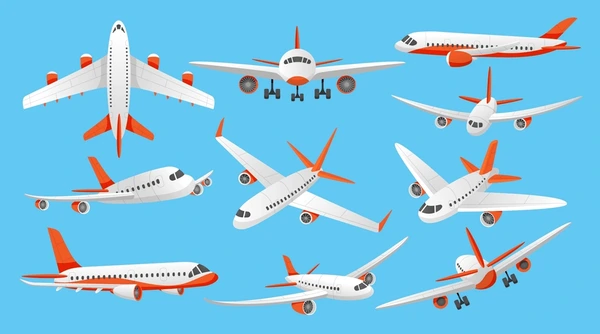
Private jet travel has long been associated with luxury, exclusivity, and convenience. Unlike commercial airlines, private aviation offers travelers the ability to fly on their own schedule, use smaller airports closer to their destinations, and enjoy personalized service onboard. In this introductory guide, we’ll explore what private jets are, who uses them, and why the private jet industry is booming. We’ll also highlight key differences between flying private and flying commercial, setting the stage for those new to the world of private flight.
The World of Private Jets at a Glance
Private jets (also called business jets or executive jets) are aircraft dedicated to transporting small groups of passengers, typically outside of the commercial airline network. They range from small turboprop planes and very light jets that carry 4-6 people, up to large long-range jets (like Gulfstream and Bombardier models) that can fly intercontinental routes with 14+ passengers. There are around 23,000 private jets in operation worldwide as of 2023, with the United States holding the largest share (roughly 65% of the global fleet) due to its high concentration of wealth and large geography.
The private jet market was valued at nearly $30 billion in 2021 and is projected to exceed $40 billion by 2028, reflecting steady growth even in the face of economic uncertainties._1742546624.jpeg) This growth has been fueled in part by the COVID-19 pandemic, which pushed many travelers (especially affluent individuals and companies) to seek the controlled environment of private flights. In fact, the COVID-19 pandemic proved a crucial factor contributing to rising demand for private jets. Private flight activity surged as health-conscious travelers looked to avoid crowded airline terminals.
This growth has been fueled in part by the COVID-19 pandemic, which pushed many travelers (especially affluent individuals and companies) to seek the controlled environment of private flights. In fact, the COVID-19 pandemic proved a crucial factor contributing to rising demand for private jets. Private flight activity surged as health-conscious travelers looked to avoid crowded airline terminals.
By 2023, private flying remained above pre-pandemic levels – with about 5.4 million private jet flights globally in 2023, still ~28% higher than in 2019. These numbers paint a clear picture: more people than ever are opting to fly private, whether for business efficiency or personal comfort.
Who Uses Private Jets?
The clientele for private aviation is diverse. Traditionally, business executives, entrepreneurs, and corporate teams form a large portion of private jet users – enabling rapid travel between meetings in different cities or visiting remote locations not well-served by airlines. High-net-worth individuals and celebrities also frequently fly private for both convenience and privacy. Private jets offer a discreet way to travel without the public exposure of commercial airports.
However, the appeal of private flying has broadened. Small and medium businesses sometimes use charter jets for important trips. Government officials and diplomats may fly private for security reasons. Even leisure travelers in groups or families occasionally charter a jet for special trips (for example, a multi-generational family vacation or destination wedding), especially when splitting the cost among several passengers.
Importantly, flying private is not only for billionaires. There are tiers of private aviation – from relatively affordable propeller planes for short hops, up to ultra-luxurious VIP airliners. New business models like membership programs and on-demand charter platforms have made private flying accessible to a wider audience of successful professionals. Later in this series, we’ll discuss options like chartering by the hour or finding discounted “empty leg” flights that can significantly lower the cost barrier.
How Private Jets Differ from Commercial Flights
If you’ve only flown on commercial airlines, stepping into the world of private jets is eye-opening. The experience is markedly different in several ways:
- Flexibility and Scheduling: With a private jet, you set your own schedule. You can depart whenever is convenient for you (pending aircraft/crew availability), rather than being limited to airline timetables. If a meeting runs late, the plane waits for you – not the other way around.
- Airport Access: Private jets can use thousands of smaller airports and executive terminals. In the U.S., private aircraft have access to around 5,000 airports, versus under 500 used by commercial airlines. This means you can often depart or land much closer to your actual destination, avoiding busy hubs. For example, instead of flying into a major commercial airport and then driving hours to a remote location, a private flight could land at a small airfield just minutes away.
- Security and Boarding: Flying private virtually eliminates the tedious security lines and boarding queues of commercial travel. There’s no need to arrive two hours early for check-in and TSA screening. Typically, you show your ID at the Fixed-Base Operator (FBO, the private jet terminal) and you’re escorted straight to your aircraft. Most private flights depart within 15 minutes of your arrival. This time savings is tremendous – studies show that by skipping the airport lines, private jet users can save 1–3 hours on each trip that would otherwise be spent waiting around.
- Comfort and Amenities: The cabin of a private jet is a far cry from a commercial airliner cabin. Even small jets feature plush, all-leather seats (often in a club-chair configuration) and ample legroom. There are no middle seats – in fact, each passenger typically gets a large swiveling seat by a window. Many jets have divans (couches) and tables for dining or work. Larger jets may include separate lounge areas, enclosed bedrooms, and even showers. The ambiance is one of a private flying lounge or office. Noise levels are often lower, and the ride can feel more relaxed with just your invited guests on board.
- Personalized Service: The flight crew on a private jet (pilots and sometimes a cabin attendant on larger jets) are focused entirely on you. They can cater the flight to your preferences – from preferred beverages and meals to specific temperature settings and music choices. Catering can be arranged from your favorite restaurant or tailored menu. It’s a bespoke experience, akin to flying in a VIP suite.
- Privacy and Productivity: On a private flight, you’re either alone or with people you know. This privacy enables candid business discussions or relaxation without eavesdropping neighbors. Many travelers find they can be highly productive on private flights – essentially turning travel time into a meeting room in the sky. Others appreciate the ability to simply rest or enjoy family time without distraction. There’s also no need to worry about other passengers’ behavior; the entire environment is under your control.
- Speed and Efficiency: While the cruising speeds of private jets are similar to commercial airliners, the overall door-to-door travel time is often much shorter. You drive right up to the private terminal (many FBOs even offer valet parking next to your plane), take off quickly, often fly direct (no layovers), and land closer to your endpoint. One analysis found that flying private can save 2–4 hours on a single trip by enabling direct routings that avoid connections. When time is money – as it is for many business users – this efficiency is priceless.
- Cost: Of course, all these benefits come at a significantly higher cost per flight than commercial economy tickets. We will delve into the costs later in Article 8, but in short, chartering even a small jet can cost several thousand dollars per flight hour. However, when multiple passengers share a private flight, the per-person cost can sometimes approach that of premium-class airline tickets, especially on shorter routes. And for those who highly value time saved, privacy, or the ability to reach remote locations, the value proposition of private flying becomes clear despite the price.
Trends and Innovations in Private Aviation
The private jet industry is continually evolving. In recent years, a few trends have shaped how people fly private;
- Membership and Charter Platforms: Companies like Wheels Up (profiled in Article 2) offer membership programs where clients pay an annual fee for access to aircraft at fixed hourly rates. Meanwhile, digital charter marketplaces (e.g., apps and websites) allow on-demand booking of private jets more easily, increasing price transparency and competition. These innovations aim to make private jet access more straightforward, somewhat analogous to how rideshare apps made hiring a car service easier.
- Fractional Ownership: Some travelers purchase a “share” of a private jet (through programs like NetJets or Flexjet). This fractional ownership grants them a certain number of flight hours per year on a fleet of jets. It’s like timeshare for aircraft – the owner pays an upfront share cost and annual fees, and the management company handles the rest. This has lowered the entry point for those who fly very frequently but don’t want the burden of owning a whole aircraft. (We’ll compare ownership vs. charter in a later article).
- New Aircraft Models: Manufacturers continue to introduce innovative jets – from ultra-long-range models that can fly farther (e.g., Bombardier Global 7500), to very light jets and turboprops that are more fuel-efficient for short hops. Notably, very light jets (VLJs) and personal jets have made private aviation accessible to new users. For example, the single-engine Cirrus Vision Jet became the world’s best-selling business jet by unit in recent years; 96 Vision Jets were delivered in 2023, the most of any model. These smaller, more affordable jets expand the range of options for travelers and charter companies alike.
- Sustainability Efforts: Private aviation faces scrutiny for its carbon footprint. In response, the industry is exploring sustainable aviation fuel (SAF), carbon offset programs, and even electric/hybrid aircraft concepts for the future. While private jets emit more CO2 per passenger than commercial flights (a 10x higher per-passenger carbon footprint is often cited, many operators and manufacturers are actively seeking greener solutions to ensure the viability and social acceptance of private flying in the long term.
- Empty Leg Marketing: As we’ll explore in Article 9, up to 30–40% of private jet. Companies have gotten creative in marketing these otherwise wasted flights at huge discounts to spontaneous travelers. This helps recover some cost for the operator and offers adventurous flyers a chance to fly private for less. The rise of apps and lists for empty leg availability is a notable trend enabling better utilization of jets.
Conclusion
Private jet travel offers an informative perspective on what air travel can be when personalized to the passenger. From the freedom to choose your schedule and avoid crowded airports, to the comfort of a plush cabin and time saved, it’s no surprise that flying private is considered the gold standard of air travel. In this introductory overview, we’ve seen that the private aviation sector is robust and growing, serving a wide array of users beyond just celebrities.
As we move forward in this 30-day content series, we will dive deeper into specific aspects of private jet travel. Upcoming articles will explore topics such as how to charter a jet, the costs involved, innovative services like membership programs, and tips for those considering their first private flight. Whether you’re an operator looking to understand passenger expectations, or a curious commercial traveler contemplating a private jet experience, this series will equip you with knowledge to navigate the exciting world of private aviation. Stay tuned!
References:


